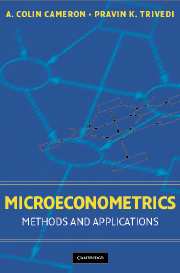 A. Colin Cameron and Pravin
K. Trivedi
A. Colin Cameron and Pravin
K. Trivedi
MICROECONOMETRICS: Methods and Applications
Cambridge University Press, New York
May 2005
PART 4 (chapters 14-20)
Part 4, consisting of chapters 14 to 20, covers the core nonlinear limited
dependent variable models for cross-section data, defined by the range of
values taken by the dependent variable. Topics covered include models for
binary and multinomial data, duration data and count data. The complications
of censoring, truncation and sample selection are also studied.
Chapters 14-15 cover models for binary and multinomial data that are standard
in the analysis of discrete choice and outcomes. Maximum likelihood
methods are dominant. Different parameterizations for the conditional
probabilities in these models lead to different models, notably logit and
probit models, which are well-established Recent literature has focused
on less restrictive modeling with more flexible functional forms for conditional
probabilities and on accommodating individual unobserved heterogeneity. These
objectives motivate the use of semiparametric methods and simulation-based
estimation methods.
Censoring, truncation or sample selection generate empirically several important
classes of models that are analyzed in Chapter 16. The long-established Tobit
model is central to this literature, but its estimation and inference rely
on strong distributional assumptions to permit consistent estimation. We also
examine the newer semiparametric methods require weaker assumptions.
Chapters 17-19 consider duration models in which the focus is on either
the determinants of spell lengths, such as length of an unemployment spell,
or on modeling the hazard rate of transitions from one initial state to another.
The relative importance of state dependence and unobserved heterogeneity as
determinants of the average length of spell is a central issue, whose resolution
raises fundamental questions about alternative modeling approaches. The analysis
covers both discrete and continuous time models, and both parametric and
semiparametric formulations, including the standard models like the exponential,
the Weibull, and the proportional hazards model. Chapter 18 covers
formulation and interpretation of richer models that incorporate unobserved
heterogeneity. Chapter 19 deals with models with several types of events using
the competing risks formulation and models of multiple spells.
Chapter 20 covers the analysis of event count of the kind very common in
health economics. There are many strong connections and parallels between
count data models and duration models because of their common foundation in
stochastic processes. We analyze the widely-used Poisson and negative binomial
regression models, together with important variants such as the two-part
or hurdle model, zero-inflated models, latent class models, and endogenous
regressor models, all of which accommodate different facets of the event
processes.
Back to Main Page
 A. Colin Cameron and Pravin
K. Trivedi
A. Colin Cameron and Pravin
K. Trivedi